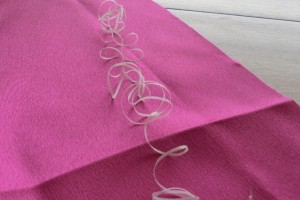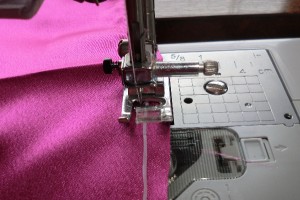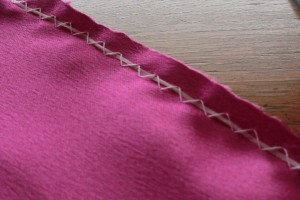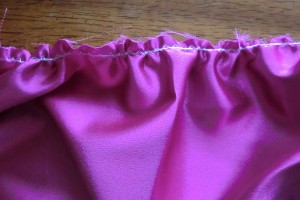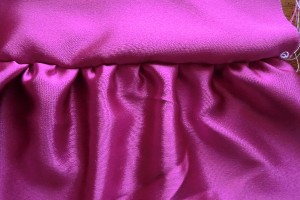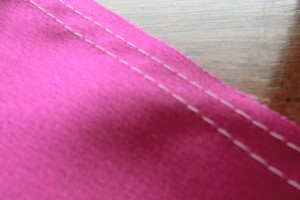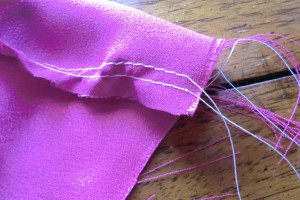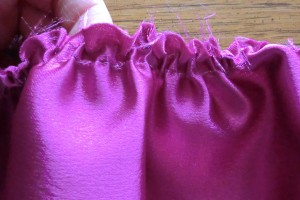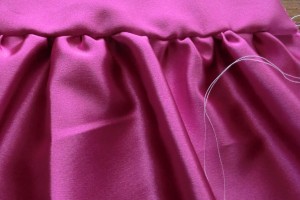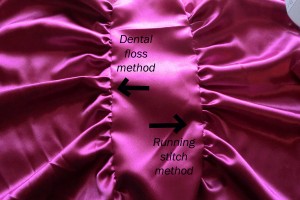Gathering methods: running stitches vs. dental floss method
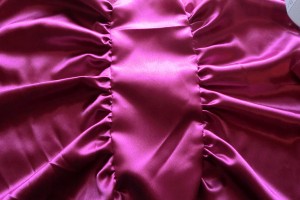 There are several ways to do gathers, but one I’d heard about but never tried is the dental floss method, which I’ll demonstrate here. Another more common way is to make a few rows of long running stitches.
There are several ways to do gathers, but one I’d heard about but never tried is the dental floss method, which I’ll demonstrate here. Another more common way is to make a few rows of long running stitches.
Disclaimer: I have never felt like I’m the best gatherer. My grandma and mom were really good sewers, but I didn’t learn when I was young. When I taught myself, I showed my grandma something I’d made and she pointed out that my gathers weren’t even enough. So I guess I now have a complex about it! I’m certainly always looking for a way to do better gathers, and I wanted to give this dental floss idea a shot.
Supplies

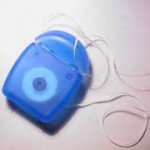
Method
Each of theses seams is gathered with a different method.
You’ll need a length of dental floss that is longer than the piece of fabric you are gathering. I’m not sure if there’s a better type of floss for this use, but I just used some waxed floss I had on hand. I could see how it would be a good idea NOT to press the fabric when the waxed floss is still in place!
Set your machine to a wide and long zigzag stitch. Place your needle down in the left-hand position of the zigzag and place the floss next to it. Lower the presser foot and stitch with the floss between the zigzags. You don’t want to catch the floss in the stitching. It’s actually really easy to do without catching the floss — easier than I expected.
You end up with this.
Start pulling the floss and gather the fabric to the desired width.
I stitched the sample to another piece of fabric to see the final effect.
ANALYSIS: One reason this method appealed to me is because often, especially on heavier fabrics, the threads on a running stitch break. The dental floss seemed stronger. This is a really lightweight fabric, so strength wasn’t as much of an issue. One difference I noticed is that the fabric slid with such ease that it was sort of hard to hold the gathers in place once I had formed them — the fabric wanted to slide back down the floss, so I placed pins on either end of the fabric and wrapped the floss around them to secure it. Then I tried to distribute my gathers more evenly. Still, they seemed to slide about more than I’d like.
On to the traditional running stitch method.
In this method, you set your machine to a long straight stitch and stitch one or two rows, leaving long tails on either end. Two rows make much better gathers than one, and two are definitely necessary on heavier fabrics to provide strength. In this method, the threads can break as you’re pulling them if your fabric is heavier, so that’s a downside.
You’ll gather the bobbin side tails with one hand and pull, gathering up the fabric. I wrap the threads around my finger as I pull to keep it secure.
You’ll get gathers like these. At this point, I was thinking that the running-thread gathers looked nicer and stayed in place easier than the dental floss gathers.
I stitched to the other side of my middle piece of fabric to examine the final effect.
When compared side-by-side, I found that I actually liked the dental-floss gathers a bit more. That surprised me because I was thinking otherwise during the experiment. In the photo above, the dental floss is on the left and the running stitches are on the right. I feel like the gathers on the left look more evenly spaced, but overall the two sides are similar.
WINNER: It’s hard for me to declare either method the hands-down winner. Each method has its merits, but in this experiment, I think the dental floss method came out a bit better.
If you have tips on making nice, even gathers, please share in the comments!

